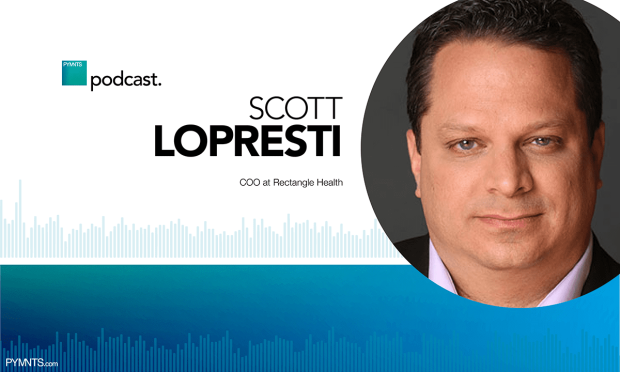Moving Healthcare Providers To A New Payments Business Model

The U.S. healthcare industry is plagued with two- and three-month billing delays and confusion about what is and isn’t covered by insurance.
Scott LoPresti, chief operating officer of Rectangle Health, told PYMNTS in an interview that it’s a process ripe for improvement.
“A product of the healthcare industry is that billing is still very much a paper process,” LoPresti said. “Multiple bills are typically sent after a service, and unfortunately, those bills tend to get ignored. That’s why revenue collection as a whole tends to lag.”
Part of the problem is the fact that there’s a huge and super-busy middleman — the insurance companies — between the doctor and patient. There are a lot of calculations that go on behind the scenes for insurers, such as deductibles, copays, co-insurance, and in-network and out-of-network rates. These complexities add to the time it takes to fulfill final cost to the patient.
“What happens is the service is provided by the [doctor], then that provider bills the insurance company and waits for an insurance payment in most instances,” LoPresti said. “The average consumer probably doesn’t know how much the insurance company is going to pick up for that procedure. As a result, they’re getting large bills way after the fact that they’re just not prepared to pay.”
A System Like No Other
LoPresti said U.S. healthcare differs from other industries because the patient can receive service and leave, without paying in full. Often, by the time the final bill gets to a patient, the balance owed can be surprising, large and unclear.
“It can be a very big strain on the individual,” he said. “As a result, people just push that bill to the side and don’t pay it. It’s become an accepted practice in healthcare to just ignore that bill as long as you can.”
Eventually collection agencies get involved, but LoPresti said that typically just drives up costs and losses, and in many cases leads to default and even personal bankruptcy.
Increased Communication, Better Results
LoPresti said the problem is “definitely a product of the payment model in the healthcare industry.”
But he said the good news is it’s also a problem that can often be prevented.
“A primary focus of our company is to try to educate [providers] on how to shift that model so they can control it better,” LoPresti said.
More times than not, that shift involves improved communications.
“Our business model is built around educating the practice on how to take more control of that payment process,” he said. “What we teach them is a way to initiate the conversation with the consumer at the point of care, or even prior to the point of care, about the payment options that are available.”
A prime example, he said, would involve discussing a flexible payment arrangement. So, instead of a patient getting hit with a surprise $1,000 bill, a provider could pre-negotiate a monthly payment that’s stretched out over the course of a year to help take the bite out of it.
“It’s just a much more affordable way to approach it,” LoPresti said, adding that it’s also a way that ultimately gets providers more money and fewer write-offs.
“It’s really about teaching them how to change that conversation from what it previously was,” he said. “A lot of it is about communication up front.”
Make It Easy
LoPresti said that after more than 25 years in the healthcare-payments business, Rectangle Health is prepared to handle any practice or provider, large or small.
“Ultimately, the payment process is not drastically disparate whether you’re looking at one type of practice or another,” he said. “They’re all roughly the same from a payment procedural standpoint.”
LoPresti added that the increased use of digital payments in offices or online has helped simplify things for practices, while also addressing current social distancing concerns.
“What we’re really focused on in 2021 is making it easier,” he said. “How do we make it easier for these practices to take what we’re giving them and use those tools to be able to better their process?”
